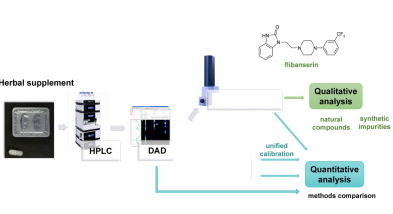
Summary
A rapid and sensitive high-performance thin layer chromatography indicating stability (SI-G-RP-HPTLC) method for the detection of flibanserin (FBN) compared to a high-performance thin layer chromatography indicating stability (SI-G) was established. -NP-HPTLC). The G-RP-HPTLC-densittry analysis was performed on the FBN using an acetone/water solvent system (80:20, v/v) as the mobile phase, while the G-NP-HPTLC-densittry analysis was performed for the FBN Ethyl acetate/methanol (95:5, v/v) system solvent. FBN was quantified with a maximum of λ = 204 nm for both techniques. The SI-G-RP-HPTLC and SI-G-NP-HPTLC methods were found to be linear in the range of 100-1600 and 200-1600 ng/range, respectively. The system fit parameters of both methods were found acceptable for FBN quantification. SI-G-RP-HPTLC is found to be more fast, accurate and sensitiveTo determine the FBN compared to the SI-G-NP-HPTLC technique. The SI-G-RP-HPTLC technique is observed to be more selective and stable indicates determination of FBN in the presence of degradation products. The FBN contents of commercial film-coated tablets were found to be 98.76% using the SI-G-RP-HPTLC technique, while the FBN contents of commercial film-coated tablets were recorded to be 96.28%. Using SI-G-NP HPTLC technology. Both green and environmentally friendly methods were evaluated using AGREE software that used 12 principles of environmentally friendly green analytical chemistry. The ecometrics for SI-G-RP-HPTLC and SI-G-NP-HPTLC are expected to be 0.86 and 0.80, respectively. The environmental values obtained for both methods indicate the environmental suitability of both methods. Based on these observations and validation studies, the SI-G-RP-HPTLC methodology was considered superior to the SI-G-NP-HPTLC technique for pharmaceutical analysis. Accordingly, the SI-G-RP-HPTLC technique can be used to evaluate the amount and stability of FBN in commercial products containing FBN.
Research paper link:https://doi.org/10.1016/j.microc.2021.105960